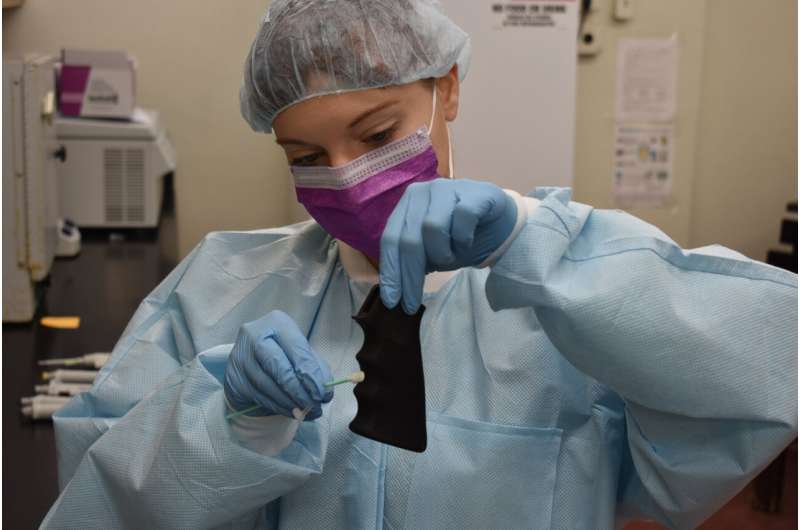This article has been reviewed according to Science X's editorial process and policies. Editors have highlighted the following attributes while ensuring the content's credibility:
fact-checked
trusted source
proofread
New simpler and cost-effective forensics test helps identify touch DNA

Television dramas like CSI and NCIS make criminal investigations look easy. In real life, DNA testing can be challenging and requires expensive equipment, special facilities, and extensive training to identify DNA from a crime scene and determine which belongs to a potential suspect and which may have been transferred from someone who was never there.
Research from the University of New Hampshire has found a less expensive and easier-to-use test to learn more about forensic touch DNA. This research has important implications for forensic investigations and being able to identify DNA from a primary contact—someone who may have committed the crime—as well as secondary DNA that was inadvertently and indirectly transferred through touch.
"So-called 'touch DNA' is a form of trace DNA that is deposited when a person touches something and leaves behind their skin cells, sweat or other fluids that contain their DNA," said Samantha McCrane, a lecturer in anthropology and co-director of UNH's Forensic Anthropology Identification and Recovery (FAIR) Lab.
"While touch DNA is often the result of direct contact, which we call primary transfer, it can also be indirectly transferred between surfaces or individuals, leaving behind secondary or even tertiary DNA."
In their study, recently published in the Journal of Forensic Sciences, researchers developed an innovative test that uses a more accessible and affordable sequence method, known as qPCR.
To test their protocol, they paired male and female volunteers and kept it simple, only looking at one marker to determine the sex of the DNA. In the trials, they first had a male participant hold a gun grip for 30 seconds before placing it down on a sterilized table. Then, a female picked up the same gun grip and held it for 30 seconds and followed that by grasping a coffee cup for 30 seconds. Afterward, the gun grip, coffee mug, and female's hand were all swabbed for DNA.
The findings with the new method found male and female DNA on the gun grip in 71% of the trials, indicating primary transfer since both participants directly touched the gun grip. Male DNA was found on the female's hand in 50% of the trials, representing secondary transfer since the DNA was transferred indirectly from the gun grip.
Male DNA on the coffee mug was recorded 27% of the time, indicating tertiary, or third level, transfer since the DNA was indirectly transferred from the gun grip to the female's hand and finally to the coffee mug.
"The challenge with transfer DNA is that it opens up the dangerous possibility of DNA ending up on items or victims at a crime scene that a person may not have touched," said McCrane. "This has occurred in multiple cases, leading to innocent individuals being charged for crimes they didn't commit."
The study also looked at the potential effects of age, ethnicity, and skin conditions on DNA transfer. Ethnicity and age did not appear to affect touch DNA deposits, and the small sample of those with sloughing skin conditions, like eczema, did not show any significant association with primary DNA transfer.
Researchers say even DNA experts cannot distinguish between different types of DNA transfer, and this understudied field lacks enough data to fully understand which variables affect direct versus indirect DNA transfer and how often it happens.
These new study results contribute to a better understanding of the conditions under which secondary and tertiary DNA transfer occurs, and researchers are hopeful this new inexpensive protocol could lead to more research, allowing for greater sample sizes and replication runs.
More information: Samantha M. McCrane et al, An innovative transfer DNA experimental design and qPCR assay to identify primary, secondary, and tertiary DNA transfer, Journal of Forensic Sciences (2023). DOI: 10.1111/1556-4029.15444
Provided by University of New Hampshire




















